March 19, 2020 report
Astronomers determine chemical composition of a nearby stellar stream

By conducting high-resolution optical spectroscopic observations of a nearby stellar stream known as Pisces–Eridanus, astronomers have unveiled essential information about its chemical nature. Results of the new study are presented in a paper published March 10 on the arXiv pre-print repository.
Stellar streams are long, thin filaments of stars orbiting galaxies, produced by the stretching action of tidal forces. For astronomers, observation of these structures could be crucial to test various galaxy formation models.
Located most likely some 420 light-years away in the Milky Way's disk, Pisces–Eridanus (or Psc–Eri for short) is a cylindrically shaped stream of almost 1,400 identified stars distributed across about 2,300 light-years. Due to its relative proximity and population size, it is perceived as an excellent laboratory to study star formation and test theories of chemical and dynamical evolution of stellar systems.
So a team of astronomers led by Keith Hawkins of the University of Texas at Austin, performed spectroscopic observations of Psc-Eri in order to investigate its chemical nature. For this purpose, they used the Tull Echelle Spectrograph on the 2.7m Harlan J. Smith Telescope at McDonald Observatory and combined the results with data from the e Large Sky Area Multi-Object Fiber Spectroscopic Telescope (LAMOST) spectroscopic survey.
"In this work, we explore the detailed chemistry of 42 Psc–Eri stream stars with high-resolution (R~ 60000) optical spectroscopic data from McDonald Observatory as well as 40 stream stars from low-resolution (R~1800) LAMOST data," the astronomers wrote in the paper.
In general, the study measured the abundance distribution of light/odd-Z, alpha, iron-peak, and neutron capture elements across the Psc–Eri stream. The results of the observations show that the stellar stream has a near solar metallicity [Fe/H] of around -0.03, with a metallicity spread of about 0.07.
According to the paper, the stream appears to have abundance dispersions that are larger than the typical uncertainties for many elements. However, the stream shows no significant abundance gradients across its major axis, except in the abundance ratio of silicon to iron [Si/Fe].
Summing up the results, the astronomers noted that the detailed chemistry of Psc-Eri is typical for the local galactic thin disk, with only some enhancements seen in several neutron capture elements like strontium, yttrium, barium and lanthanum. The new data also indicate that Psc-Eri is much younger than previously thought. The researchers calculated that the stream is about 120 million years old.
"The Psc–Eri stream, was initially thought to be as old as 1 Gyr, yet its stars shared a rotation period distribution consistent with the 120-Myr-old Pleiades cluster. (...) The abundance of Li indicates that Psc–Eri is ∼120 Myr old, consistent with the gyrochronology result," the authors of the paper concluded.
More information: The Chemical Nature of the Young 120-Myr-old Nearby Pisces-Eridanus Stellar Stream Flowing through the Galactic Disk, arXiv:2003.04940 [astro-ph.GA] arxiv.org/abs/2003.04940
© 2020 Science X Network




















